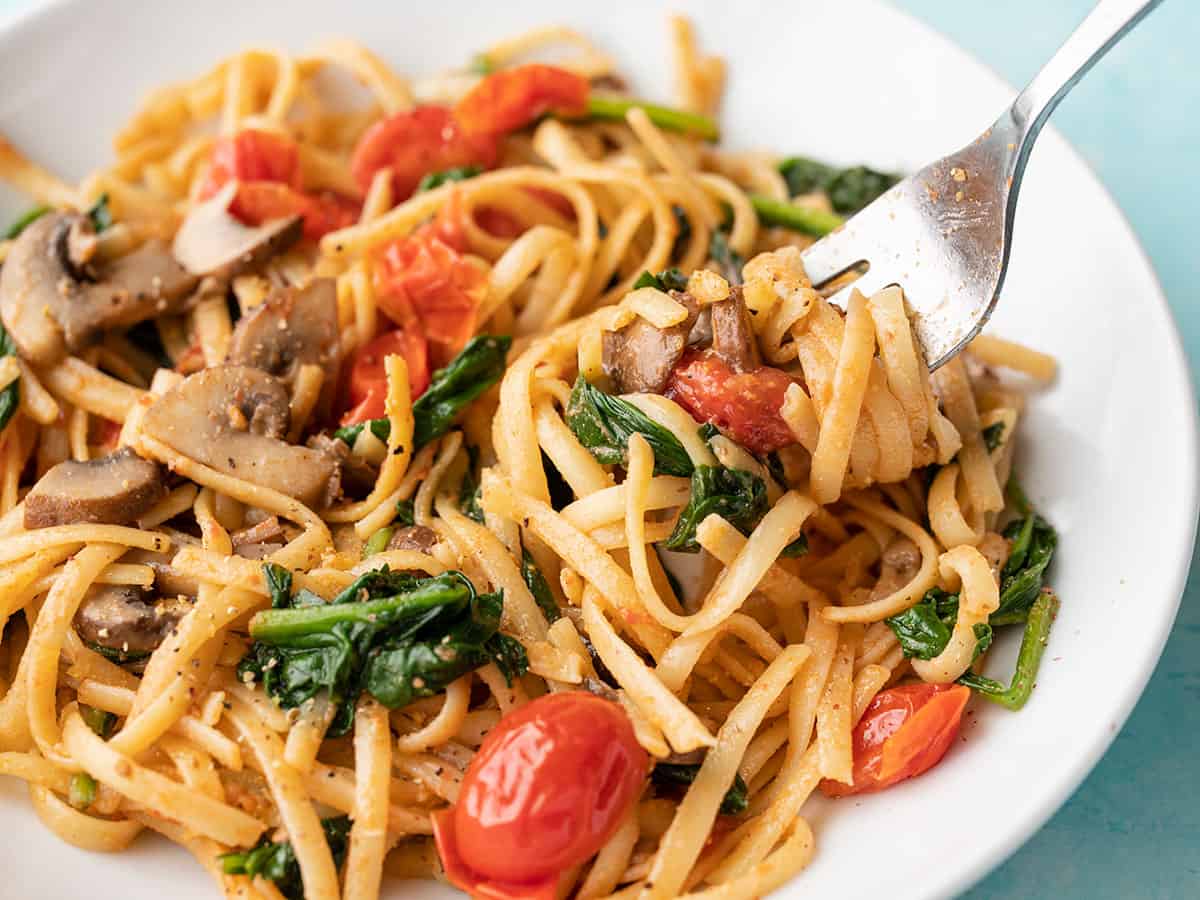Embark on a culinary journey through Italy’s vibrant pasta landscape with this exploration of delicious flexitarian pasta dishes. We’ll delve into the art of crafting three versatile pasta sauces – a vibrant tomato-based delight, a luscious creamy creation, and a fragrant pesto masterpiece – each bursting with fresh flavors and plant-based goodness. Discover the perfect pasta shape for each sauce, understanding the interplay of textures and tastes. We’ll unveil the secrets to a rich and satisfying lentil Bolognese, a vegetarian protein powerhouse, and a stunning roasted vegetable and ricotta pasta dish, complete with step-by-step instructions and mouthwatering descriptions.
From the deep crimson hues of sun-ripened tomatoes in the rich sauce to the creamy swirls of ricotta clinging to perfectly roasted vegetables, this guide offers a visual feast alongside the culinary adventure. Learn to select the ideal pasta shape to complement each sauce, considering the delicate dance between texture and flavor. We’ll explore the nutritional benefits of plant-based ingredients, highlighting the versatility and healthfulness of flexitarian eating. Prepare to elevate your pasta game to new heights!
Popular Flexitarian Pasta Sauce Variations
This section explores three delectable and nutritious flexitarian pasta sauce variations, showcasing the versatility of plant-based ingredients in creating flavorful and satisfying Italian meals. Each recipe balances vibrant flavors with a focus on fresh, wholesome components. These sauces are easily adaptable to your preferred spice levels and dietary needs.
Tomato-Based Sun-Dried Tomato and White Bean Sauce
This vibrant sauce bursts with the sweet and tangy flavors of sun-dried tomatoes, complemented by the earthy richness of cannellini beans. The combination creates a hearty and satisfying sauce perfect for a weeknight meal.
The preparation begins by sautéing finely chopped garlic in olive oil until fragrant. Then, add a handful of chopped sun-dried tomatoes (oil-packed, drained) and cook for a few minutes until softened. Next, stir in a can of drained and rinsed cannellini beans, a splash of vegetable broth, and a pinch of red pepper flakes for a touch of heat. Simmer for 10-15 minutes, allowing the flavors to meld. Finally, blend the mixture until smooth, or leave it slightly chunky for a rustic texture. Season generously with salt, black pepper, and fresh basil before serving. This sauce pairs beautifully with penne, rigatoni, or fusilli pasta.
Creamy Roasted Butternut Squash and Sage Sauce
This luxuriously creamy sauce boasts the natural sweetness of roasted butternut squash, enhanced by the aromatic notes of fresh sage. The absence of cream is compensated by the natural creaminess of the squash and the addition of nutritional yeast for a cheesy, savory depth.
Start by roasting cubed butternut squash with olive oil, salt, and pepper until tender. Once cool, blend the roasted squash with vegetable broth until smooth and creamy. In a separate pan, sauté finely chopped shallots and fresh sage leaves in olive oil until fragrant. Combine the squash puree with the shallot and sage mixture, stirring in a generous amount of nutritional yeast for a cheesy flavor. Adjust seasoning with salt and pepper to taste. This sauce is particularly delicious with creamy pasta shapes like tagliatelle, fettuccine, or pappardelle.
Pesto-Based Spinach and Walnut Pesto
This vibrant green pesto offers a lighter, yet equally flavorful alternative to traditional basil pesto. The spinach provides a slightly earthy note, complemented by the richness of walnuts and the brightness of lemon juice.
Begin by blanching fresh spinach leaves until wilted, then thoroughly drain and squeeze out excess moisture. Combine the spinach with walnuts, grated Parmesan cheese (or nutritional yeast for a vegan option), garlic cloves, lemon juice, and olive oil in a food processor. Pulse until a smooth paste forms, adjusting the oil as needed to reach your desired consistency. Season with salt and pepper to taste. This pesto is exceptionally versatile and pairs well with a variety of pasta shapes, including linguine, spaghetti, or farfalle.
Pasta Sauce Comparison
| Sauce Type | Key Ingredients | Flavor Profile | Suitable Pasta Shapes |
|---|---|---|---|
| Tomato-Based | Sun-dried tomatoes, cannellini beans, garlic, red pepper flakes | Sweet, tangy, slightly spicy | Penne, rigatoni, fusilli |
| Creamy | Roasted butternut squash, sage, shallots, nutritional yeast | Sweet, savory, creamy | Tagliatelle, fettuccine, pappardelle |
| Pesto-Based | Spinach, walnuts, Parmesan cheese (or nutritional yeast), garlic, lemon juice | Earthy, nutty, bright | Linguine, spaghetti, farfalle |
Nutritional Benefits of Flexitarian Pasta Sauces
These flexitarian pasta sauces offer a wealth of nutritional benefits, primarily due to the inclusion of plant-based ingredients. The tomato-based sauce provides a good source of fiber from the beans and lycopene from the tomatoes, an antioxidant linked to various health benefits. The creamy butternut squash sauce is rich in Vitamin A and fiber, while the pesto-based sauce offers healthy fats from walnuts and iron from spinach. The use of nutritional yeast in the creamy sauce adds a significant boost of B vitamins. All three sauces are naturally lower in fat and calories compared to traditional cream-based sauces, making them a healthier and more sustainable choice.
Pasta Shapes and Sauce Pairings

Choosing the right pasta shape to complement your flexitarian sauce is key to a truly delightful Italian meal. The interplay of texture and flavor between the pasta and sauce creates a harmonious culinary experience. Consider the sauce’s consistency, its dominant flavors, and the pasta’s ability to hold the sauce and contribute its own textural element. A well-chosen pairing elevates the entire dish.
The following pairings showcase the versatility of Italian pasta and the delicious possibilities of flexitarian cooking. Each combination has been carefully selected to ensure a balanced and satisfying meal.
Pasta Shape and Sauce Pairings
This section details five popular pasta shapes and their ideal flexitarian sauce pairings, highlighting the rationale behind each choice.
- Pasta: Spaghetti. Sauce: A vibrant, chunky tomato sauce with roasted vegetables (like zucchini, bell peppers, and eggplant) and white beans. Imagine the deep red of the sauce, speckled with the bright greens and yellows of the vegetables, clinging beautifully to the long, slender strands of spaghetti. The smooth, slightly firm texture of the spaghetti provides a satisfying counterpoint to the hearty, rustic sauce. The sauce’s rich tomato flavor complements the subtle taste of the pasta, while the vegetables add a burst of freshness and color. The white beans contribute a creamy texture and a subtle earthiness.
- Pasta: Penne. Sauce: A creamy mushroom and spinach sauce with a touch of nutmeg. Picture the ridged penne, each tube capturing the rich, earthy green sauce. The creamy texture of the sauce coats the penne perfectly, the nutmeg adding a warm, aromatic note. The penne’s ridges provide extra surface area for the sauce to cling to, ensuring every bite is flavorful. The earthy mushrooms and spinach offer a delightful contrast to the creamy sauce.
- Pasta: Farfalle (bowties). Sauce: A light lemon-herb sauce with artichoke hearts and cherry tomatoes. Envision the cheerful yellow-and-orange bowtie pasta tossed with a bright, lemony sauce, punctuated by the vibrant green of the artichoke hearts and the deep red of the cherry tomatoes. The farfalle’s unique shape catches the sauce beautifully, and its slightly firm texture holds up well to the lighter sauce. The lemony brightness cuts through any richness, while the artichoke hearts and tomatoes add depth and visual appeal.
- Pasta: Fusilli. Sauce: A robust pesto sauce with sun-dried tomatoes and toasted pine nuts. Imagine the swirling fusilli, coated in a vibrant green pesto sauce, flecked with the deep red of the sun-dried tomatoes and the creamy white of the toasted pine nuts. The spirals of the fusilli perfectly cradle the pesto, allowing the flavors to blend seamlessly. The pesto’s intense flavor is balanced by the sweetness of the sun-dried tomatoes and the nutty crunch of the pine nuts.
- Pasta: Conchiglie (shells). Sauce: A rich, meatless Bolognese sauce with lentils and carrots. Visualize the deep red-brown of the meatless Bolognese coating the curved shells, the lentils adding small flecks of brown, and the carrots contributing a vibrant orange hue. The concave shape of the conchiglie provides ample space to hold the hearty sauce, making each bite a flavorful experience. The texture of the sauce, combined with the slightly firm shells, offers a satisfying contrast.
Recipe Development
This section details the creation of a hearty and flavorful lentil Bolognese, a fantastic flexitarian alternative to traditional meat-based versions. The recipe emphasizes simple techniques and readily available ingredients to achieve a rich, satisfying sauce perfect for your favorite pasta. The deep, earthy notes of the lentils are beautifully complemented by the sweetness of the vegetables, creating a complex and delicious flavor profile.
Lentil Bolognese Recipe
This recipe provides a step-by-step guide to preparing a delicious and nutritious lentil Bolognese. The careful selection of ingredients and cooking techniques ensures a satisfying texture and rich flavor. The addition of carrots, celery, and onions provides a well-rounded depth of flavor and a vibrant color to the sauce.
Ingredients:
* 1 tablespoon olive oil
* 1 large onion, finely chopped
* 2 carrots, finely chopped
* 2 celery stalks, finely chopped
* 2 cloves garlic, minced
* 1 cup brown or green lentils, rinsed
* 1 (28-ounce) can crushed tomatoes
* 1 (15-ounce) can tomato sauce
* 1 cup vegetable broth
* 1 teaspoon dried oregano
* 1/2 teaspoon dried basil
* 1/4 teaspoon red pepper flakes (optional)
* Salt and black pepper to taste
* Fresh parsley, chopped (for garnish)
Instructions:
1. Heat the olive oil in a large pot or Dutch oven over medium heat. Add the onion, carrots, and celery and cook until softened, about 5-7 minutes. Imagine the vibrant colors of the vegetables, the onions turning translucent, the carrots softening to a deep orange, and the celery offering a subtle green hue to the mixture.
2. Add the minced garlic and cook for another minute until fragrant. The aroma at this stage is intoxicating, a blend of sweet and savory notes.
3. Stir in the lentils, crushed tomatoes, tomato sauce, vegetable broth, oregano, basil, red pepper flakes (if using), salt, and pepper. Bring the mixture to a simmer, then reduce heat to low, cover, and cook for 30-40 minutes, or until the lentils are tender. The sauce will thicken as it simmers, the lentils releasing their starch and creating a beautiful, rich consistency.
4. Taste and adjust seasoning as needed. A sprinkle of freshly grated Parmesan cheese (optional) would enhance the richness further.
5. Serve over your favorite pasta, garnished with fresh parsley. The final dish is a feast for the eyes and the palate, a vibrant and flavorful pasta dish bursting with color and texture.
Vegetable Roles in Flavor Enhancement
The inclusion of carrots, celery, and onions plays a crucial role in developing the complexity and depth of flavor in the lentil Bolognese. Each vegetable contributes unique characteristics. The onions provide a sweet base note, the carrots add a subtle earthiness and sweetness, while the celery offers a slightly bitter counterpoint that balances the overall flavor profile. The combined effect is a harmonious blend of sweet, savory, and slightly bitter notes that elevate the sauce beyond the simple lentil base. The vegetables also contribute to the overall texture, creating a pleasing contrast against the soft lentils.
This exploration of Delicious Italian Flexitarian Pasta Dishes has unveiled a world of culinary possibilities, demonstrating the ease and deliciousness of incorporating plant-based ingredients into classic Italian fare. From the vibrant colors of roasted vegetables to the satisfying heartiness of lentil Bolognese, these recipes offer a delightful balance of flavor and nutrition. Whether you’re a seasoned cook or a kitchen novice, the step-by-step instructions and detailed descriptions empower you to create stunning, flavorful, and healthy pasta dishes that will impress your family and friends. So, gather your ingredients, embrace the vibrant flavors of Italy, and embark on your own flexitarian pasta adventure!
General Inquiries
Can I substitute ingredients in the recipes?
Yes, many ingredients can be substituted based on preference and availability. However, be mindful that substitutions may alter the final flavor and texture.
How can I make these dishes gluten-free?
Use gluten-free pasta. Ensure all other ingredients are naturally gluten-free or use certified gluten-free alternatives.
How long can I store leftover pasta dishes?
Store leftovers in an airtight container in the refrigerator for up to 3-4 days.
Are these recipes suitable for freezing?
Many of these recipes freeze well. Allow them to cool completely before freezing in airtight containers for up to 2-3 months.


